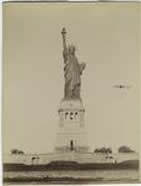Nathan is listed separately from the others as “Nochem Pumerantz”, age 21 (although we believe he was really 23) on the last line of the page. Chana-Raisel is listed as 40 although she was most likely 43 or 44.
The FRIESLAND / LA PLATA was built 1889. 7 ,116 gross tons, length 437ft x beam 51.2ft, clipper stem, one funnel, four masts (rigged for sail), steel hull, single screw and a speed of 15 knots. Accommodation for 226-1st, 102-2nd and 600-3rd class passengers. Built by J & G.Thomson, Glasgow and launched for the Red Star Line on 15th Aug.1889. Her maiden voyage from Antwerp to New York started on 7th Dec.1889 and her last voyage on this service started on 10th Jan.1903.

THE NOORDAM

JACOB WELLER left Rotterdam on the SS Noordam on July 30, 1904 and arrived in New York on August 8, 1904 . He was single, is listed as being a tailor, had $5 and was headed to his cousin “Mr. Movsahowitz at 43 Edrid St. NY”. (We have no record of any such cousin.) The ship manifest lists him as "Jacob Welles", age 20, from London.
CHANA BEREZNYAK-FRIEDMAN sailed on the SS Noordam, leaving Rotterdam on April 8th, 1905 and arriving in NY on April 19th. She stated she was going to her husband, A. Friedman at 310 "Kinsington" St., NYC. She is listed on the manifest as Chaina Friedman, age 25, wife, from Prusany and is listed as having no money.
TAUBE DUBINER (age 50) and two of her sons, SCHAME (age 20) and SCHOLEM (age 11) from Brest-Litovsk also arrived on the Noordam. They sailed from Rotterdam and arrived in NY March 3, 1908. Taube, who was already widowed, is listed as being 4'10.5" tall with brown hair while Schame was 5'4" tall with brown hair and gray eyes. The were all headed to Taube's other son, Davis-Libe Dubiner who was living at 42 Gouverneur St. in NY.
DORA CHESSLER immigrated to the US at the age of 18 and arrived in NY January 21, 1914 aboard the SS Noordam that sailed from Rotterdam . She stated she was from "Wisoiki, Russia" and was going to her brother, Yankel Czesler at 317-319 E. 3rd Street, NYC.
CHAIA SAFER-BLINDERMAN and two of her daughters, RACHEL BLINDERMAN and ANNA BLINDERMAN, immigrated to the US on June 9, 1914. Chaia listed her brother "Izik Safer" as her closest relative back home.
NOORDAM / KUNGSHOLM 1901
The NOORDAM was a 12,531 gross ton vessel built in 1901 by Harland & Wolff, Belfast for the Dutch company, Holland America Line. Her details were - - length 550.3ft x beam 62.3ft, one funnel, two masts, twin screw and a speed of 15 knots. There was accommodation for 286-1st, 292-2nd and 1,800-3rd class passengers. Launched on 28th Sep.1901, she sailed from Rotterdam on her maiden voyage to New York on 1st May 1902. On 17th Oct.1914 she was damaged by a mine in the North Sea, but repaired and resumed sailing on 26th Mar.1915. On 3rd Aug.1917 she was again damaged by a mine and was then laid up for the duration of the war. She resumed service between Rotterdam, Plymouth, Brest and New York on 9th Mar.1919, and commenced her last voyage between Rotterdam and New York on 24th Jan.1923. She then went to the Swedish America Line, who refitted her to carry 478-cabin class and 1,800-3rd class passengers and renamed her KUNGSHOLM. On 15th Mar.1923 she started sailings between Gothenburg and New York, and on 7th Nov.1924 between Gothenburg, Halifax and New York. On 6th Oct.1926 she went back to her previous name of NOORDAM and resumed sailing between Rotterdam and New York and in December of that year, became a third class passenger ship only. She commenced her last voyage on this service on 16th Apr.1927, was then sold and scrapped at Hendrik Ido Ambacht in 1928. [North Atlantic Seaway by N.R.P.Bonsor, vol.3. p913.]

THE POTSDAM

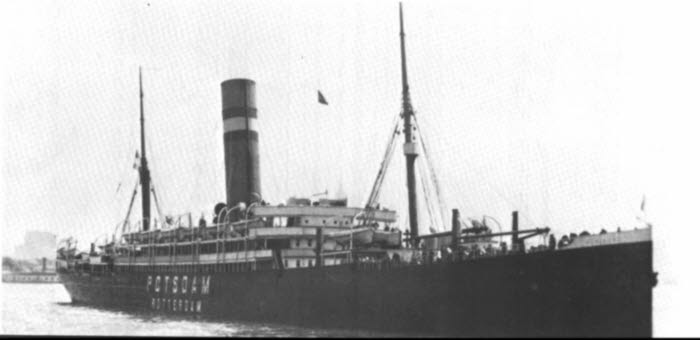
PAULINE SAFER arrived on the POTSDAM August 23, 1904. The Potsdam Ship’s Manifest lists “Pesche Seifer” on the 3rd line. It says she was 20 when she arrived in 1904, she was a “tailoress”, she paid her own passage, she had $2.50 with her and she was going to her brother-in-law—J. Friedman 127 E. 59th St. ??? She is also listed on the Detained Aliens list. The reason for her detention is listed as "Sis" (whereas others are listed as "Bro") and the disposition is "Cousin, Mrs. Fanny Friedman, Date: 24 AUG 1904, Meals: 1 bkfst, 1 dinner, 1 supper". To date, we do not know who Fanny Friedman is.
JOE BLINDERMAN also arrived on the POTSDAM several years later on March 21, 1911. He listed his brother-in-law Abraham Friedman on 115 Broome Street at his US destination.
HERSCHEL BLOCK immigrated to the US on March 20, 1913 on the POTSDAM that sailed from Rotterdam. He came from "Pusene, Russia" and he was 26 years of age and married. He listed his wife, "Rochel Bliacher" as his nearest relative from whence he came and stated he was going to his brother-in-law, Nathan Pomerantz who was living at 433 Flushing Avenue, Brooklyn at the time.
The POTSDAM was a 12,606 gross ton ship, built in 1899 by Blohm & Voss, Hamburg for the Holland-America Line. Her details were - length 550ft x beam 62ft, one funnel, two masts, twin screw and a speed of 15 knots. There was accommodation for 282-1st, 210-2nd and 1,800-3rd class passengers. Launched on 15/12/1899, she sailed from Rotterdam on her maiden voyage to New York on 17/5/1900. In 1904 her funnel was lengthened by 23 ft to improve draught and made this ship easily recognizable. She commenced her last voyage from Rotterdam to New York on 24/4/1915, and then went to the Swedish American Line and was renamed "Stockholm".

THE PENNSYLVANIA

The Pennsylvania sailed from Hamburg. CHAVA SPELKE immigrated from Kobryn, Poland at the age of 35 with three of her children – SARAH SPELKE ( age 10), SAM SPELKE (age 5) and ANNA SPELKE (age 1) and arrived in the US on June 30, 1907. Her husband David had immigrated to the US in 1904 and was working as a blacksmith – although we suspect – based on their daughter Anna's age, David made at least one trip back to Kobryn. Their youngest son, Henry, was born in the US in 1908.
PENNSYLVANIA / NANSEMOND 1896
The PENNSYLVANIA was a 12,891 gross ton ship, length 557.5ft x beam 62ft, one funnel, four masts, twin screw and a speed of 14 knots. There was accommodation for 162-1st, 197-2nd and 2,382-3rd class passengers. Built by Harland & Wolff, Belfast, she was launched for Hamburg America Line on 10th Sep.1896. Her maiden voyage from Belfast to New York started on 30th Jan.1897 and on 22nd Mar. 1897 she commenced Hamburg - New York sailings. On 24th Sep.1902 she rescued the crew of 13 from the sinking Norwegian barque BOTHNIA who had been fighting against rising water for 17 days. The PENNSYLVANIA rammed and sank the Hamburg schooner GERTRUD on 8th Mar.1910 in the mouth of the River Elbe. The same year she was rebuilt to 13,333 gross tons with accommodation for 404-2nd and 2,200-3rd class passengers and on 18th Jul.1914 commenced her last Hamburg - New York sailing. At the outbreak of the Great War, she took refuge in New York and in April 1917 was seized by US Authorities. Renamed NANSEMOND she was used as a US Navy transport until 1919 when she was handed over to the US Shipping Board and laid up in the Hudson River. In 1924 she was scrapped.[North Atlantic Seaway by N.R.P.Bonsor, vol.1,p.402][Great Passenger Ships of the World by Arnold Kludas, vol.1,p.32]


THE RIJNDAM
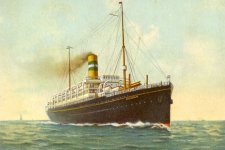
CELIA BLINDERMAN (indexed as Ciwje Blmderman) immigrated to the US March 15, 1910 on the SS Rijndam at the age of 16. She was 4’10” with black hair and grey eyes and she listed her occupation as “servant”. She and her sister Ronya who arrived in 1913 both listed Abram Friedman, 260 Madison St., NYC as their contact in the US.
Built by Harlan & Wolff Limited, Belfast, Northern Ireland, 1901. 12,527 gross tons; 575 (bp) feet long; 62 feet wide. Steam triple expansion engines, twin screw. Service speed 15 knots. 2,282 passengers (286 first class, 196 second class, 1,800 third class). Built for Holland - America Line, Dutch flag, in 1901 and named Rijndam. Rotterdam-New York service. Laid up in 1917 due to World War I. Chartered by United States Navy, American flag, in 1918. Used as a troopship. Rotterdam-New York service 1919-28. Scrapped in Holland in 1929.

THE ROTTERDAM
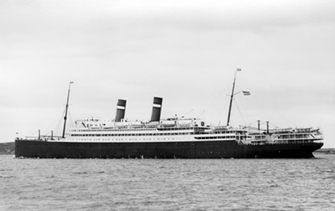

DAVIS-LIBE DUBINER, age 19, (aka David Rubin) also immigrated on the Rotterdam. He sailed from Rotterdam to NY arriving July 23, 1900. He was single, from Wisoki-Litovsk and was traveling to his brother, M. Dubiner at 27 Market St. in NY.
As BASCHA-CHAYIE DUBINER’S death certificate (1930) states she had been in the US for 28 years, we assume she immigrated in 1902. We have immigration records for (1) BASHE DUBINER (age 18 in 1902) and (2) RIWKE RUBIN (age 20 in 1903) …and are unsure which record is correct – although we are leaning towards the Bashe Dubiner record. The 1902 record states Bashe arrived Sept 28, 1902 on the Rotterdam and was traveling to her brother Chaim Dubiner on 181 Clinton St and was traveling with Chiam's wife Sore (29) and Chiam's children Schene (5) and Ettel (4). We have two unknown Dubiner's... could one be Chiam?
RONYA BLINDERMAN immigrated on the SS Rotterdam on March 20, 1913. Ronya and her sister Celia (who arrived in 1910) both listed Abram Friedman, 260 Madison St., NYC as their contact in the US.
ROTTERDAM 1908
This was the fourth ship with this name owned by the Holland America Line. She was a 24,149 gross ton ship, length 650.5ft x beam 77.4ft, two funnels, two masts, twin screw and a speed of 16 knots. There was accommodation for 530-1st, 555-2nd and 2,124-3rd class passengers. Built by Harland & Wolff, Belfast, she was launched on 3rd Mar.1908 and on 13th Jun.1908 started her maiden voyage from Rotterdam to New York. Her last voyage started on 23rd Feb.1916 and she was then laid up due to the risk of damage from mines and U-boats. She resumed Rotterdam - Brest - New York sailings on 24th Jan.1919 and in 1920 was converted from coal to oil fuel. In Apr.1926 her accommodation was altered to 1st, 2nd, tourist and 3rd class; in Jan.1930 to 1st, tourist and 3rd class; in Jun.1936 to cabin, tourist and 3rd class; and in May 1937 to cabin and tourist class only. Her last Rotterdam - New York - Rotterdam voyage started on 21st Nov.1939 and in Jan.1940 she was scrapped at Hendrik Ido Ambacht. [North Atlantic Seaway by N.R.P.Bonsor, vol.3,p.913]

THE BRESLAU
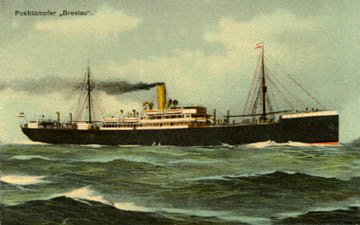
KASRIL WEALER and his wife SARAH BLITZ-WEALER immigrated from Vilna, Poland in 1912 with their two year old son, LOUIS WEALER. Their ship landed in Galveston, TX. On the way over, Louis contracted chicken-pox and they were quarantined until he recovered. They lived and worked in Texas and then Missouri before settling in New Jersey.
BRESLAU / BRIDGEPORT / LARKSPUR 1901
The BRESLAU was a 7,524 gross ton ship, length 429.3ft x beam 54.3ft, one funnel, two masts, twin screw and a speed of 13 knots. Accommodation for 60-2nd and 1,660-3rd class passengers. Built by Bremer Vulkan, Vegesack, she was launched for North German Lloyd, Bremen on 14th Aug.1901. Her maiden voyage started 23rd Nov.1901 when she left Bremen for New York , and on 3rd Apr.1902 she started her first Bremen - Baltimore sailing. 10th Sep.1903 first Bremen - Baltimore - Galveston voyage, 24th Mar.1910 first Bremen - Philadelphia and 6th May 1914 first Bremen - Boston - New Orleans sailing. Her last voyage for NGL started 8th Jul.1914 when she sailed from Bremen for Emden , Boston , New York and New Orleans , where she took refuge on the outbreak of the Great War. Seized by US Authorities in Apr.1917, she became the US Navy transport BRIDGEPORT . In 1943 she was converted to the US Hospital ship LARKSPUR and in 1946 became the US Army Transport BRIDGEPORT. Scrapped in 1948.

THE CZAR

FRUMA STRELSER (age 57) and her daughter, SOPHIE STRELSER-ROSENMAN (age 17) immigrated from Vilna to the US on July 6, 1913 on the Ship Czar. They paid their passage themselves and had $50. Fruma is listed as a housewife and Sophie (listed as Scheina) was a "tailoress". Sophie is listed as 5'3". My earliest memories of Sophie are that she was considerably shorter than me - and I'm only 5'2"! "Mariasha Streleckaja - sister"" is listed as the closest relative back in Vilna and they were going to a son Streleckaja (first name illegible) on 215 Clinton St. in NYC.
All of Fruma’s other children had immigrated prior to their arrival. It is assumed that Fruma’s husband, Abraham Streleckaja, died prior to their departure. Upon immigration, the name was changed from Streleckaja to Strelser.
CZAR / ESTONIA / PULASKI / EMPIRE PENRYN 1912
The CZAR was a 6,503 gross ton ship, built by Barclay, Curle & Co, Glasgow in 1912 for the Russian American Line. Her details were - length 425ft x beam 53.2ft, two funnels, two masts, twin screw and a speed of 15 knots. There was accommodation for 30-1st, 260-2nd and 1,086-3rd & 4th class passengers. Launched on 23rd March 1912 , she sailed from Libau on her maiden voyage to Copenhagen and New York on 30th May 1912 . Her last voyage on this service started on 17th Jul.1914 and on 13th Sep.1914 she commenced Archangel - New York sailings. After the Russian revolution, she was transferred to British registry and placed under the management of the Cunard SS Co. and in 1921 was returned to the East Asiatic Co of Copenhagen (owners of the Russian American Line). They renamed her ESTONIA and placed her on the transatlantic service under the description of Baltic American Line. On 11th Jan.1921 she sailed from Glasgow for New York , Danzig and Libau, and on 23rd Feb.1921 commenced Libau - Danzig - Boston - New York sailings. In Feb.1925 she was refitted to accommodate 290-cabin and 500-3rd class passengers and in Mar.1926 was again altered to 110-cabin, 180-tourist and 500-3rd class. Her last Danzig - Copenhagen - Halifax - New York voyage started on 31st Jan.1930 and she was then sold to the Polish owned Gdynia-America Line. On 13th Mar.1930 she started a single round voyage between Danzig , Copenhagen , Halifax and New York and was then renamed PULASKI. She started sailing between Danzig , Halifax and New York under this name on 25th Apr.1930 and commenced her last N.Atlantic voyage - Gdynia - Copenhagen - Halifax - New York on 18th Aug.1935. Transferred to the Gdynia - Buenos Aires service on 28th Feb.1936 and started her last voyage on this route on 21st Apr.1939. On 24th Aug.1939, just before the outbreak of WWII, she sailed from Gdynia for Falmouth and was used as a troopship during WWII, was renamed EMPIRE PENRYN under British registry in 1946 and was scrapped at Blyth in 1949. [North Atlantic Seaway by N.R.P. Bonsor, vol.3, p.1356; vol.4, p.1511-12] [South Atlantic Seaway by N.R.P. Bonsor, p.465]

THE GOTHLAND

YITZCHACK-ISAAC SAFER and his wife, MOLLIE DUBINER-SAFER immigrated to the USA together on March 29, 1921. We believe he was 63 and she was 59 however their passports state he was born in 1861 and she was born in 1864 which would have made them 60 and 57 respectively. They arrived on the Gothland and went to Philadelphia rather than New York because there was an influenza epidemic in NY at the time. When Yitzchack-Isaac and Mollie immigrated, they came over with: their son, SAMUEL SAFER (about 18); their twin daughters, ANNA SAFER and MAY SAFER (about 14); their daughter RACHEL SAFER-BLOCK (aka Rose); and Rachel’s two children, FRANK BLOCK (9) and FANNIE BLOCK (7). (Rachel was married to Hershel Block who was already in NY.)
The Gothland was a 7,755 gross ton ship, built in 1893 by Harland & Wolff, Belfast as the "Gothic" for the White Star Line's New Zealand service. Length 490.7ft x beam 53.2ft (149,55m x 16,21m), one funnel, four masts, twin screw and a speed of 14 knots. Launched on 28th Jun.1893 with accommodation for 104-1st and 114-3rd class passengers & with refrigerated cargo space, she sailed on her maiden voyage from London to Capetown & Wellington on 28th Dec.1893. In June 1906, she was damaged when her wool cargo caught fire & was beached & flooded at Plymouth. Converted to an emigrant carrier with third class accommodation for 1,800 passengers, all in 4 berth cabins, she was purchased by the Red Star Line, registered under the Belgian flag & renamed "Gothland" in 1908. She commenced her first Antwerp - New York voyage on 11th Jul.1908, made a single round voyage between Hamburg, Antwerp, Quebec & Montreal on 6th May 1911 & started her last Antwerp - New York sailing on 24th Jun.1911. Between 1911-1913 she resumed the name of "Gothic" & sailed on the UK - Australia/New Zealand service for the White Star Line. She went back to the name "Gothland" & returned to the Antwerp - New York route for Red Star Line on 23rd Apr.1913. On 23rd Jun.1914 she stranded on the Gunnar Rocks, Scilly Isles, was towed off after three days & was repaired at Southampton. On the 20th Apr.1916 she commenced the first of three or more voyages between New York, Falmouth & Rotterdam for the Belgian Relief Commission & returned to Antwerp - New York voyages with cargo only on 6th May 1919. She resumed passenger voyages on 7th Aug.1920 & commenced her last voyage between Antwerp and Philadelphia in March 1925. Sold in Nov.1925 and scrapped at Bo'ness the following year.

THE AQUITANIA

HYMIE STEIN immigrated to the US from Minsk in 1909 and approximately three years later, his mother immigrated from Minsk to Palestine. In 1926, Hymie went to Palestine to visit his mother. While he was there he met and married SHIFRA QUATINSKY. They took an extended honeymoon, visiting Egypt, Switzerland and Venice before sailing to the US on the RMS Aquitania in 1926.
Gross Tonnage - 45,647 tons Dimensions - 264.76 x 29.56m (868.7 x 97ft) Number of funnels - 4 Number of masts - 2 Construction - Steel Propulsion - Quadruple-screw Engines - Steam turbines Service speed - 23 knots Builder - John Brown & Co Ltd, Glasgow Launch date - 21 April 1913 Passenger accommodation - 597 1st class, 614 2nd class, 2,052 3rd class
The Aquitania was the longest serving Cunard liner built in the 20th century and survived service in both World Wars. Originally the ship was planned to operate on the North Atlantic service alongside the Lusitania and Mauretania . The contract to build the ship went to John Brown & Co and great publicity was given to the fact that it would be the largest liner in the world. The Aquitania was launched on 21 April by the Countess of Derby in front of a crowd of over 100,000 people. Cunard made sure that lifeboat accommodation was provided for all those on board, in the light of the Titanic disaster. It was announced in February 1914 that Captain William Turner would be the first master of the ship.
The Aquitania 's passenger accommodation was superior to anything seen on the North Atlantic before. The first class drawing room was decorated in the Adam style, copied from certain features in Landsdowne House in London . The walls were adorned with prints of English seaports and portraits of Royalty and prominent people of the day. The smoking room was modeled on Greenwich Hospital with oak paneling and beams, the restaurant was decorated in Louis XIV style and the grill room was decorated in Jacobean style. With public rooms of this standard and passenger cabins superior to those on previous Cunarders it was no surprise that the Aquitania became one of the best-known Cunard liners.
The Aquitania left Liverpool on its maiden voyage on 30 May 1914 , bound for New York . The tragic loss of the Empress of Ireland, and 1,000 of those on board, the day before overshadowed this event. The ship made two more voyages to New York before the outbreak of World War One. It was then requisitioned by the Government to serve as an armed merchant cruiser and was converted for this role in Liverpool . It was then commissioned into the Royal Navy on 7 August and its first assignment was to patrol the Western Approaches, returning to the Mersey on 16 August.
On its next voyage in this role it collided with the Leyland ship Canadian on 22 August, during thick fog, and had to return to Liverpool . The subsequent enquiry concluded that the Aquitania was too large to be used as an armed merchant cruiser. Repair work on the ship was finished by the end of 1914. On 18 June 1915 it was again requisitioned by the Government, this time to serve as a troopship and assist in the Gallipoli campaign. On 25 June it left Liverpool with a full complement of over 5,000 troops on board. After three voyages as a troop transport it was then converted into a hospital ship and served this role during December 1915 and January 1916.
On 10 April 1916 it was de-commissioned from Government service and was reconditioned by Harland & Wolff in order to return to Cunard service. When this was almost complete the Government was forced to requisition the Aquitania once again to serve as a hospital ship in November 1916. The ship served in the Mediterranean for the rest of the year and was then anchored in the Solent for the whole of 1917. The entry of the USA into the war in December 1917 brought the ship back into service to transport the American Expeditionary Force. After the war it was also used in the repatriation of Canadian troops.
From November 1919 until June 1920 the ship underwent an extensive refit at Armstrong Whitworth & Co on the Tyne . Whilst this was being done the opportunity was taken to convert the ship to oil burning, as opposed to coal. After trials north of Scotland , it made its next voyage from Liverpool to New York on 17 July. After returning from this the ship was to operate on the Southampton - Cherbourg - New York route, along with the Mauretania and Berengaria. During annual winter refits in 1926 1927 and 1928 the passenger accommodation was extensively modernized. In 1930 it was even used as an art gallery for one voyage.
In 1932 the Aquitania was used as a cruise ship for the first time. It left New York on 3 February and cruised around the Mediterranean . Further cruises on this route and New York-Bermuda route were accomplished later in the year. In November the ship underwent considerable internal reconstruction. First class accommodation was reduced to 650, tourist class was enlarged but the passenger accommodation reduced to 600 and third class was altered to cater for 950 passengers. All public rooms were renovated and a theatre was added. For the rest of the period up until the Second World War it continued a mixture of Atlantic crossings and cruises.
The Aquitania was then requisitioned as a troop transport on 21 November 1939 . At first it was used to transport Canadian troops. During 1940 it underwent a refit in America and was defensively armed with six inch guns. From March onwards it was based in Sydney transporting Australian and New Zealand troops, also making two passages between Pearl Harbor and San Francisco . For the remainder of the war it was employed on the Atlantic , and after the war had ended in the repatriation on Canadian and American troops. Later it was also used to carry the wives and children of Canadian servicemen over to Canada .
On 1 April 1948 it was released by the Ministry of Transport and returned to Cunard. It was then chartered by the Canadian Government to carry Canadian emigrants between Southampton and Halifax. This contract was renewed in 1949. By 1 December 1949 this role had been fulfilled and later that month Cunard announced that the Aquitania would be withdrawn from service. On 9 January 1950 Messrs Hampton & Sons Ltd were employed to auction the vessels furnishings and equipment. Later that month the ship was sold to the British Iron & Steel Corporation Ltd for £125,000. The ship then sailed from Southampton to Faslane, in Scotland where it was broken up. --------- Adapted from the Cunard Archives

SS VADERLAND (3)
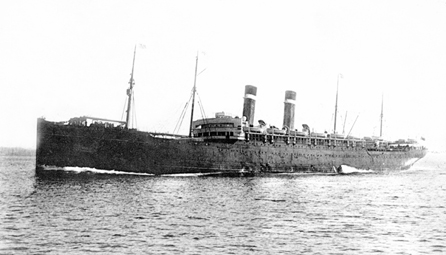
“ Gittel Weiler” ( GUSSIE WELLER-SHAPANKA) , age 17, born in Vilna, arrived in New York July 23, 1906 on the Vaderland that sailed from Antwerp . Her US contact was her brother: "J. Weler" living on 237 E. 113 or 115 St., NYC.
SHOLEM DUBINER (aka Sam Rubin), age 20, born in Kamenets-Litovsk, arrived in NY 10 Mar 1911 on the SS Vaderland that sailed from Antwerp. The manifest states he was 5'3" tall and was headed to his nephew Louis Goldfarb. We can only assume one of Sholem's sisters married a man named Goldfarb.
Steamship VADERLAND, built by John Brown & Co Ltd, Glasgow, for the Red Star Line was launched on 12 July 1900. 11,899 tons; 170,92 x 18,35 meters (560.8 x 60.2 feet, length x beam); 2 funnels, 4 masts; twin-screw propulsion, service speed 15 knots; accommodation for 342 1st-, 194 2nd-, and 626 3rd-class passengers.
- 8 December 1900 , maiden voyage, Antwerp- Southampton- New York (British flag).
- 11 December 1901 , first voyage for the American Line (chartered), Southampton- Cherbourg - New York .
- 8 April 1901 , last voyage for the American Line, Southampton- Cherbourg- New York (3 roundtrip voyages).
- 16 May 1903, first voyage, Antwerp - New York (Belgian flag).
- 25 July 1914 , last voyage, Antwerp - New York .
- 22 September 1914 , first voyage, Liverpool - New York (British flag).
- December 1914, first voyage for White Star-Dominion (chartered), Liverpool-Halifax-Portland.
- February 1915, last voyage for White Star-Dominion, Liverpool-Halifax-Portland (3 roundtrip voyages).
- 1915, renamed SOUTHLAND (International Navigation Co); taken up as a troopship. 2 September 1915 , torpedoed in the Aegean Sea ; reached port; repaired.
- August 1916, first voyage for White Star-Dominion (chartered), Liverpool-Quebec-Montreal.
- 4 June 1917 , torpedoed and sunk by German submarine U.70 off the Irish coast (4 lives lost)
[Noel Reginald Pixell Bonsor, North Atlantic Seaway; An Illustrated History of the Passenger Services Linking the Old World with the New (2nd ed.)

THE BERLIN

ISRAEL POMERANZ immigrated to the US in 1895. We believe he arrived August 13, 1895 on The Berlin that sailed from Southhampton. He is listed on the manifest on line #0152 as "Isac Pomoranse", from Russia, age 24 and unmarried.
Built by Caird & Company, Greenock, Scotland, 1875. 5,491 gross tons; 513 (bp) feet long; 44 feet wide. Compound engine, single screw. Service speed 16 knots. 1,770 passengers (170 first class, 100 second class, 1,500 third class).
Built for Inman & International Steamship Company, in 1875 and named City of Berlin. Liverpool-New York service. Sold to American Line, in 1893 and renamed Berlin. Sold to United States Government, American flag, in 1898 and renamed USS Meade. Scrapped in 1921.

THE BULGARIA
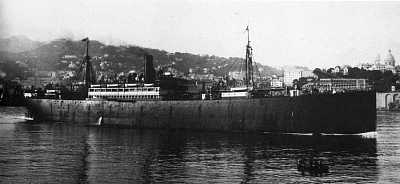
Photograph of the BULGARIA leaving the harbor at Genoa.
FANNIE POMERANTZ arrived in the US as "Frume Pomerancz" on 29 Aug 1899. She came on the ship BULGARIA that sailed from Hamburg. She was 16 years of age and was traveling alone to meet her father, David "Pomerance", in New York. He had paid her passage and she had $25 with her. Her last residence was in "Kemenests". She was able to read and write and was in good health. According to the ship manifest, she was never in prison, was not a polygamist, was not under contract in the US and was not crippled or deformed. She is listed on line 3, page 0651 of the ship manifest.
BASCHA CHAYIE (Rebeccah) RUBIN-RADISCH ... MAY HAVE ... immigrated to the US as "Riwke Ruben" on 18 Jul 1903. She was 20 years old and single. She claimed her last place of residence was "Sokolki" (Wysoke?). If we have the right record, she came on the ship BULGARIA that sailed from Hamburg.
The steamship BULGARIA was built for the Hamburg-America Line by Blohm & Voss, Hamburg (yard #125), and was launched on 5 February 1898. 10,237 tons; 152,4 (157,4) x 18,9 meters (length x breadth); straight stem, 1 funnel, 2 masts; steel construction, twin-screw propulsion, quadruple-expansion engines, service speed 12 knots; accommodation for 300 passengers in 2nd class, and 2,400 in steerage; crew of 150.
10 April 1898, maiden voyage, Hamburg - Halifax - New York. 1-24 February 1899. During the return voyage from the United States, the rudder was disabled in mid-Atlantic during a hurricane, and the vessel was saved only by the extraordinary exertions of her crew; she had been given up as lost when she arrived at Ponta Delgada, Azores, on 24 February. 1906. She was rebuilt: 11,494 tons, steerage passengers only. 1 February 1913, last voyage, Hamburg - Boston - Baltimore. 1 April 1913, pretended sale, without payment, to the Unione Austriaca, as a result of a fare-war with the Canadian Pacific Line on the Mediterranean-Canada route; renamed CANADA. April 1913, first voyage, Trieste - Quebec - Montreal. 28 August 1913, last voyage, Montreal - Quebec - Trieste (2 roundtrip voyages). 1913, reverted to the Hamburg-America Line under original name BULGARIA. 6 December 1913, resumed Hamburg-Boston-Baltimore service. 11 July 1914, last voyage, Hamburg-Baltimore (arrived 27 July). 6 April 1917, seized at Baltimore by the U.S. Government; renamed HERCULES (U.S. Army transport). 1919, renamed PHILIPPINES (U.S. Shipping Board). 1924, scrapped at New York.

S/S AMSTERDAM (1)

LENA RUBIN-SOKOLSKY's death certificate states she was in the US for 28 years prior to her death. Based on that we have found an immigration record for "Leie Sokolski", ethnicity Russian, Hebrew, last place of residence "Wijsoki", married, age 27 who arrived in the US on July 16, 1903 on the AMSTERDAM that sailed from Rotterdam. She is listed on line 22 of the manifest. We believe this is Leah.
SS AMSTERDAM: 2,949 gross; 320.3ft x 39.1ft.; Built in1879 in Dumbarton at A. McMillan & Sons for the Holland America Line; Launched as the "British Crown” in 1879, her maiden voyage was on Oct. 15, 1879 - Liverpool- Philadelphia. Her l ast Liverpool- Philadelphia voyage was on Aug 19 1885 . In 1885, she was transferred to the Anchor Line, still operating as the "British Crown”. In 1887, she was refitted to carry 80-1st, 80-2nd and 800-3rd class passengers and was t ransferred to the Furness Line ; Dec 1887 she started on Rotterdam - New York service and was immediately sold to the Holland America Line and renamed AMSTERDAM . She made regular runs to and from Rotterdam - New York from 1888 – 1893. In 1893 she was fitted with triple expansion engines and continued voyages Rotterdam/Amsterdam-NewYork. In 1899 her accommodations were altered to 2nd and 3rd class only and in 1905 she was sold to Italian owners and renamed "Amsterda".

THE STATENDAM
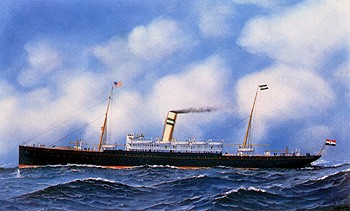

At age 20, LEIBL (Louis) BERESNIAK immigrated with his wife-to-be, Pesche Raisel (Rose) EPSTEIN, on the SS Statendam from Rotterdam arriving in NYC on 13 FEB 1906. Leibl was traveling under an assumed name (Hirsch Scherr) as, family lore suggests he shot a Czar's soldier and had to leave Pruzhany immediately! He and Rose were married in NY.
Leibl stated he was going to his brother-in-law, A. Friedman, on 364 Madison St., NYC. Pesche stated she was going to a cousin at the same address. They were both coming from Prusan. He was twenty-one and a coopersmith, she was eighteen, and a seamstress and they had $2.50 between them.
SS STATENDAM (1898) Holland-Amerika Lijn ... Built by Harland & Wolff, Belfast (10,491gross tons; 163x18m; 15 knots; 376 passengers in 2 classes + 1028 steerage). Sailed on Rotterdam-New York route. Joined British Allan Line in 1911 and renamed SCOTIAN , subsequently bought by the Canadian Pacific Steamships in 1915 and renamed MARGLEN 1922. Broken up at Genoa 1927.

SS Carmania

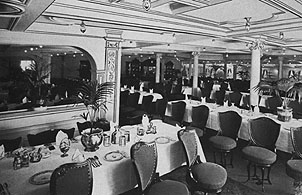
LENA WELLER-DONSKY left Europe in 1914 when she was about 20 years old. Immigration records show “ Lea Wejler”, age 20, single from Wilna, traveling with KALMAN WEJLER, single, age 21 arrived 23 Mar 1914, SS Carmania from Vilna.
Specifications: Length: 675 feet (206.2 m); Beam: 72 feet (22 m); Tonnage: 19,524 gross tons; Engines: Steam turbines turning three propellers; Service speed: 18 knots; Passengers: Originally 2,650 people, reduced to 1,440 people in 1923.
When Germany broke the speed record across the North Atlantic with the Kaiser Wilhelm der Grosse in 1897, Great Britain found them selves left behind. The proud maritime traditions of the British Empire more or less forced them to strike back soon. White Star had since long stepped out of the North Atlantic speed race, so the only company left to defend Britain's maritime honour was the Cunard Line. But they did not have the money to compete.
However, Cunard's chairman Lord Inverclyde soon found a solution. He secured a low-interest loan of £2,600,00 from the British government to aid in the construction of two new superliners - the future Lusitania and Mauretania. The government made two conditions, though. First of all, these two new ships would have to be fast enough to win back the Blue Riband from the Germans. Second, they would be constructed in a way so that they in the event of war could be converted into armed merchant cruisers.
When the plans for these new liners began to form, it became clear that they were to become both the largest and the fastest ships in the world. But it was not yet clear how they would be able to reach the 24.5-knot average speed required. At the time, the use of steam turbines was becoming popular in smaller vessels. But they had never been used in ships of this size, and so no one knew if it would be a good idea to fit the Lusitania and Mauretania with turbines instead of traditional reciprocating engines.
Cunard soon came up with a way to answer this tough question. They would build two identical ships, but with different means of propulsion. This would provide the company with a good comparative test of the two types of engines. To make everything as equal as possible, the two ships would be built by the same shipyard - John Brown & Co. Ltd.
The first of the two ships, the Caronia, was fitted with the traditional type of reciprocating engines. She was launched on July 13th, 1904 and set out on her maiden voyage on February 25th 1905, four days after her sister - Carmania - had been launched.
February 21st, 1905, was a day of great public interest. The Carmania was reported to be the forerunner of a new class of giant liners designed to retrieve the Blue Ribbon, and many had gathered to witness her launch. After having been fitted out, the Carmania was ready for her sea trials. At this early stage of her life she gave clear evidence of the reliability of steam turbines by exceeding her sister's top speed by over two knots.
The two sisters Caronia and Carmania represented a new stage in ship design in the Cunard Fleet. Earlier, the funnels had been divided into five equal parts where one fifth was painted black and the other four in Cunard's familiar orange-red colour. But on the Caronia and Carmania the ship's proportions had changed and so the funnels were instead divided into four parts, with the top quarter painted black.
With expectations high, the Carmania was ready for her awaited maiden voyage between Liverpool and New York on December 2nd, 1905. Several engineers were on board the new ship to supervise the performance of her turbines during the crossing. Upon the Carmania's arrival in New York a few days later, they were all pleased to report that the engines had worked splendidly. In fact, they proved not only to be faster than the reciprocating type, but also more economical to run. The question of the Lusitania's and Mauretania's engines had once and for all been answered - they would both be powered by turbines.
Through the following years, Caronia and Carmania maintained Cunard's Liverpool-New York service and were joined by the new Lusitania and Mauretania in 1907. As expected, their turbines gave them the speed to beat the Germans. In 1910, the Carmania got her first taste of bad luck when a fire broke out on board the ship while at its dock in Liverpool. The fire brigade was soon on the job, but it took them some time to fight the blaze. When finally extinguished, the fire had caused great damage. Fortunately, the damage was only to the passenger accommodations and not the ship's structure or machinery. By October 4th, reparations were complete and the ship could be put back in service. Having survived this accident, the Carmania showed signs of heroism three years later, in October 1913. While en route from New York to Liverpool, the Carmania intercepted an SOS call from the emigrant ship Volturno. The Volturno, which was on its way from Rotterdam to America with emigrants, was on fire caused by the ship's cargo of barium oxide. Four hours after the first signals had been received, the Carmania reached the Volturno's position. Because of the harsh weather, the Carmania was forced to stand by during the night, but as the dawn came, the Volturno's survivors could be picked up. 103 passengers and 30 crewmembers of the Volturno were lost. Awards of gallantry were subsequently presented to the Carmania's commanding officer Captain Barr and the rest of her crew.
In August the following year, World War I broke out. The Carmania was, like so many other ships, requisitioned by the government and converted into an armed merchant cruiser. This use of the great liners was soon to be proven unsuitable, but the Carmania was one of the few ships that made good use in this guise. In September of 1914, under the command of Royal Navy Captain Noel Grant, the Carmania intercepted the Hamburg-Amerika liner Cap Trafalgar, also converted and armed, in the waters off Trinidad. A fierce battle took place and although the Carmania's bridge caught fire, she managed to keep firing at the Cap Trafalgar. After an hour of fighting, the Cap Trafalgar took on a list and then went down at the head. The Carmania had received a total of 79 hits, and seven crewmembers were lost in the battle. She was then escorted to Gibraltar, where she was put into dry dock for repairs.
The Carmania was ready for service again on November 23rd. The ship patrolled the coast of Portugal and the Atlantic Islands until May of 1915, when she was called in to assist in the Gallipoli campaign in the Mediterranean. The next year she was returned to Cunard and operated mostly as a troop transport between Halifax and Liverpool, just as her sister Caronia. When the Great War finally came to an end, the Carmania and Caronia were kept on to return Canadian soldiers to their home country.
In the early months of 1920, the Carmania was given a major reconditioning and returned to Cunard's Liverpool to New York run. In 1923 she again had a refit during which her passenger accommodations were reduced to 1,440 people, mainly to make her suitable as a winter-month cruise ship. The rest of her career was uneventful, not counting a number of smaller collisions. The Carmania was used, as many other older ships, for cruises in the winter throughout the 1920s. But the Great Crash of 1929 made times worse for the shipping companies. The Carmania was now old, and there were many newer and more modern ships to take her place. And so, in March 1932, she was sold to the shipbreaking firm of Hughes Bocklow & Co. She was subsequently scrapped at Blyth.

SS Finland

ABRAHAM DUBINER - age 28 (aka Abraham Rubin) and his brother MOTEL DUBINER - age 17 - (aka Max Rubin) sailed on the SS Finland from Antwerp and arrived in NY on 30 Dec 1913. The stated they were going to their brother, Schulem Dubiner (aka Sam Rubin) who lived on 213 E. 7th Street at the time. Abraham's wife and children arrived in NY in 1920. It is believed that Abraham went back to Kamenets-Litovsk and then permanently immigrated to the US in 1915.
Built by W. Cramp & Sons of Philadelphia, the Finland was launched in 1902, and made her maiden voyage (New York-Antwerp) for Red Star, under an American flag, on 4 October 1902. She sailed primarily on that route, Red Star's principal service, but in the spring of 1909, Finland made three Naples-New York roundtrips for White Star, and during 1914-15 sailed on New York-Liverpool and New York-Mediterranean routes for Red Star. Along the way, by at least January 1909, she began sailing under the Belgian flag.
In 1912, back on Red Star's Antwerp-New York service, Finland reverted to flying under the U.S. flag. In April 1915, she was chartered to Panama Pacific for six months, on a New York-Panama Canal-San Francisco route. She returned to IMM service -- International Mercantile Marine Co. owned Red Star, White Star and a number of other lines -- and was placed on the American Line's New York-London and New York-Liverpool services until she was taken over as a U.S. troopship in 1917. Although she was torpedoed off France in 1917, Finland survived both that attack and the rest of the war, and returned to service in 1920. She ran on Red Star's Antwerp-New York route and American's New York-Plymouth-Hamburg route before being sold to Panama Pacific in November 1923. The Finland was scrapped in 1928.

RMS Homeric
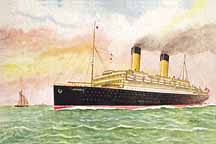
LEAH DUBINER (age 62), her daugher GAIMENDEL (age 18) and her son MENDEL (age 17) sailed on the Homeric from Cherbourg and arrived in NY 20 Nov 1924. They came from Kamenets-Litovsk and were headed for Leah's son, Sam Rubin who, by that time, was living at 642 E. 9th St., NYC.
Launched: 1913 (as the German Columbus);
Volume: 34,352 gross tons;
Length: 774 feet
Demise: retired due to Depression and scrapped in 1936
The German line Norddeutscher Lloyd ordered two sister ships to be lauched in 1913. One was to be named Columbus, and the other Hindenburg. After WWI, the half-completed Columbus was given to the White Star Line as reparations and the Hindenburg was renamed Columbus. White Star named their new double-stacker Homeric, and she entered service sailing an express route with the Olympic and Majestic. She was noted as being the largest double-screw vessel in service, and one of the steadiest ships afloat (before the invention of stabilizers) and was very popular with the public. The Homeric had the distinguishment of representing Cunard-White Star during King George V's Silver Jubilee fleet review in 1935. All in all, this ship had a short career. The Depression forced the Cunard-White Star Line to retire the Homeric prematurely, and she was sold for scrap.

United States

SIRILA DUBINER and two of her children,
SHOLEM and
DERCE sailed on the
United States from Copenhagen, arriving in New York 23 August, 1920. They were going to meet their husband - father, Abraham Dubiner.
The manifest states Sirila was 5'1" and had black hair and brown eyes.
The UNITED STATES was built by A.Stephen & Sons, Glasgow in 1903 for the Scandinavia-American Line of Denmark. She was a 10,095 gross ton ship, length 500.8ft x beam 58.3ft, one funnel, two masts, twin screw and a speed of 15 knots. There was accommodation for 130-1st, 140-2nd and 1,400-3rd class passengers. Launched on 30/3/1903, she sailed from Copenhagen on her maiden voyage to Christiana (Oslo), Christiansand and New York on 3/6/1903. In October 1922, her accommodation was altered to carry cabin and 3rd class only, and in February 1928 to cabin, tourist and 3rd class. She commenced her last voyage on 25/10/1934 when she left Copenhagen for Oslo, Christiansand, New York (dep 10/11/1934), Christiansand, Oslo and Copenhagen. On 2/9/1935 she was damaged by fire at Copenhagen and was scrapped the same year at Leghorn. [North Atlantic Seaway by N.R.P.Bonsor, vol.3,p.1240]

Susquehanna

Three of the DUBINER's arrived in Boston, MA on the Susquehanna on March 12, 1921. CHINEZA DUBINER (age 27) and her brothers AJZYK (23) and CHIAM (17) were all headed to their brother, Sam Rubin who lived at 624 E. 9th St., NY.
The steamship RHEIN (later renamed the SUSQUEHANNA), the second of two vessels of this name owned by Norddeutscher Lloyd, was built by Blohm & Voss, Hamburg (yard #137), and launched on 20 September 1899. 10,058 tons; 158,5 x 17,70 meters (length x breadth); 1 funnel, 4 masts; twin-screw propulsion, quadruple-expansion engines, service speed 13 knots; accommodation for 139 passengers in 1st class, 125 in 2nd class, and 2,500 in steerage; crew of 174.
The RHEIN was the type-ship of the Norddeutscher Lloyd RHEIN-class of steamships, designed as freight/emigrant carriers. 9 December 1899, maiden voyage, Bremen-New York. 6 May 1900, first voyage, Bremen-Baltimore. 1900-1911, primarily Bremen-New York and/or Baltimore; also used as a naval transport during the Boxer Expedition and later. 11 September 1901, first voyage, Bremen-Suez Canal-Australia. 23 November 1904, last voyage, Bremen-Suez Canal-Australia (4 roundtrip voyages). 1906, passenger accommodation altered to 302 in 2nd class ("including sofas") and 2,774 in steerage. 18 May 1911, first voyage, Bremen- Philadelphia. 9 April 1914, last voyage, Bremen-New York-Baltimore. 16 July 1914, last voyage, Bremen-Baltimore (arrived 29 July). August 1914, interned at Baltimore. 6 April 1917, seized at Baltimore by the U.S. Government; renamed SUSQUEHANNA (U.S. Navy transport). September 1917-September 1919, middle two masts shortened. 1919, transferred to U.S. Shipping Board; laid up. 4 August 1920-6 April 1921, 6 roundtrip voyages in charter to the U.S. Mail Lines, New York - Bremen - Danzig; accommodation for 500 passengers in cabin and 2,500 in 3rd class. 4 March-31 August 1922, 5 roundtrip voyages in charter to the U.S. Lines, New York - Plymouth - Cherbourg - Bremen; laid up. 1925, sold to Fincke, Bangert & Co, Philadelphia. November 1928, sold to Japan for scrapping. 25 February 1929, arrived at Yokohama under the Japanese flag; scrapped.

SS RUSSIA/WAESLAND
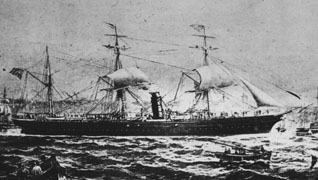
David 'Pomeranz' departed Liverpool, England 22 Dec 1897 on the SS Waesland and arrived in the US on 3 Jan 1989 at the port of Philadelphia. We know he made at least one trip to the US before this one. The ship manifest lists him as a shoemaker (?) and states he had $31 and was going to his two brothers 'Babl' (Samuel?) and 'Israel' Pomeranz at 38 East Broadway in NYC.
One of the cornerstones in the Cunard Line’s fleet was the line’s famous conservatism. Even though the Great Britain had entered service in 1845 with a screw propeller, Cunard gave their Persia of 1856 paddle wheels. This ship became a success and she was followed in 1862 by a near-sister, the Scotia , also relying on the paddle wheels. The same year, the propeller driven steamer China entered service, and as she resembled the Scotia , she was perfect to compare with. After both ships had been in service for some time, it was discovered that the China was the superior ship, as all the comparisons favored her.
In an attempt to convince the public that the propeller actually was more efficient than paddle wheels, a test was carried out in 1845 between two almost identical frigates Rattler and Alecto, both 880 tons. The propeller driven Rattler was chained stern-to-stern with the paddle wheel driven Alecto as the battle begun. Both vessels steamed on at full power in opposite directions, and the Rattler, with her propeller, towed the Alecto, stern first, at a speed of 2.7 knots.
Cunard had to face it. If they were supposed to continue being one of the most prestigious shipping companies in the world, they had to rely on new technique. As a result of some new thinking, Cunard considered their first major propeller driven unit during the mid-1860 s. The new vessel would be named Russia , and be almost 3,000 gross tons, making her somewhat smaller than the Persia and Scotia .
The Russia was constructed at J. & G. Thomson Limited in Glasgow . She was fitted with three masts and a single funnel. Without the characteristic look of the paddle wheels, her sides looked quite bare and naked. The Russia was equipped with the distinctive clipper bow and the sleek and streamlined look made the Russia appear a very powerful vessel.
And powerful she was. Even though she never captured the Blue Riband, she was known as one of the fastest liners on the North Atlantic . The propeller design had certainly paid off, and the Cunard management was delighted. However, as the Russia only had one screw, she was very dependent on her sails. If the propeller shaft snapped in the middle of the Atlantic , the ship would still be able to continue the voyage without too much delay thanks to the sails. True, the arrival at port might be two or three weeks late, but at least the steamer did not have to suffer the indignity of being towed into harbor. Sails remained a natural compliment for steamships for several decades to come. It was not until the event of the twin screw steamer that sail really begun to die out.
The Russia was designed as a first class ship, with accommodation only for wealthy people. Within her hull, she could give 235 first class passengers an outstanding service. Still, many people were confused why such a large ship as the Russia could not accommodate more passengers. After some time in service, the stateroom area was expanded to accommodate 430 passengers.
Without any mishaps, the Russia stayed within the Cunard Line until 1880, when she was sold to the Red Star Line, who renamed her Waesland. In connection with the Red Star Line-takeover, the former Russia was lengthened to 132 metres and her gross tonnage was increased to 4,752. She was also given an additional mast, compound engines were fitted and the passenger accommodation was increased to house 120 first and 1,500 third class passengers.
- In September 1895 the vessel was chartered by the American Line, for their Philadelphia to Liverpool route. The liner continued to sail the oceans with distinction into the 20 th century. The last year for the Waesland was 1902. Perhaps she would have lived on for yet another few years if it had not been for a devastating collision on March 5, with the British ship Harmonides. Unfortunately, the former Russia suffered heavy damage and went down. One of the trend-setting ships in the Cunard Line was now gone forever.
The Russia/Waesland - Specifications:
- Length: 358 feet (109.4 m)
- Beam: 42 feet (12.8 m)
- Tonnage: 2,959 gross tons
- Engines: Steam engines powering a single propeller.
- Service speed: 12.5 knots
- Passengers: 235 (later 430) people
PETERSBURG/THURINGIA
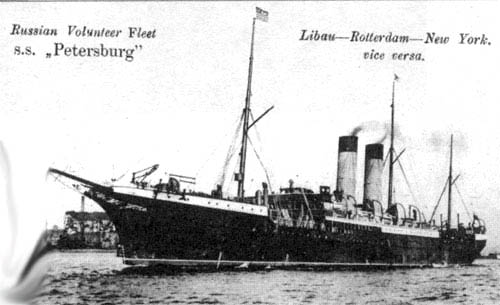
ISRAIL STRELETSKY immigrated to the US at age fourteen. He arrived on the PETERSBURG 12 Apr 1907. He is listed as traveling with his sister SORE STRELETSKY who was eighteen and a tailoress. They both listed their last residence as Pradir or Pradin (Radin?) and stated they were going to their brother MR. STRELETSKY at 315 Lispenard, NY. They were both of light complexion, he had brown hair and eyes, she had black hair and brown eyes. ISSUE: To the best of our knowledge, ISRAEL did not have a sister SARAH. At present,we are speculating that ISRAEL's niece, BESSIE ZEMSER, may have mis-represented herself as SARAH STRELETSKY. Having been denied entry to the US previously due to an eye infection, BESSIE may have returned under an assumed name. As we have not been able to find any record of her entry to the US, and the age and timing are right, we entertain this as a possibility.
The Russian Volunteer Fleet was founded 1878 at St. Petersburg and started sailings from Odessa to Vladivostok in 1880. Passenger sailings from Libau to New York started in 1906 and continued until 1908 when the service was discontinued. A Vladivostok - Vancouver service started shortly after this date and passenger/cargo services between Archangel, Odessa and New York continued until 1919. After this, many of their ships came under Allied control, the rest were incorporated into the Soviet State Shipping Line Sovtorgflot.
Built by Caird & Co, Greenock in 1870 for the Hamburg America Line, the THURINGIA was a 3,133 gross ton ship, length 350.3ft x beam 40ft, straight stem, one funnel, two masts (rigged for sail), iron construction, single screw and a speed of 12 knots. There was capacity for 102-1st, 136-2nd and 620-3rd class passengers. She was one of a class of seven near-sister ships. Launched on 18/5/1870, she sailed from Hamburg on her maiden voyage to New York on 27/10/1870. She continued on this service until commencing her last Hamburg - Havre - New York voyage on 12/5/1875, and was then laid up. In 1878 she was sold to the Russian Volunteer Fleet and renamed PETERSBURG. Renamed "St Petersburg" in 1892, she was transferred to the Imperial Russian Navy in 1893, renamed "Berezan", rebuilt as a minelayer and stationed in the Black Sea. Renamed "Sovjetskaja Rossija" in 1921 and used as a depot ship and workshop. Bonsor states that she was still in service in 1939 and was probably lost during World War II, whereas Duncan Haws says that she was broken up in 1925. [North Atlantic Seaway by N.R.P. Bonsor, vol.1, p.390] [Merchant Fleets by Duncan Haws, vol.4, Hamburg America Line, p.34] - [Posted to The ShipsList by Ted Finch - 22 July 1998]
EISENACH
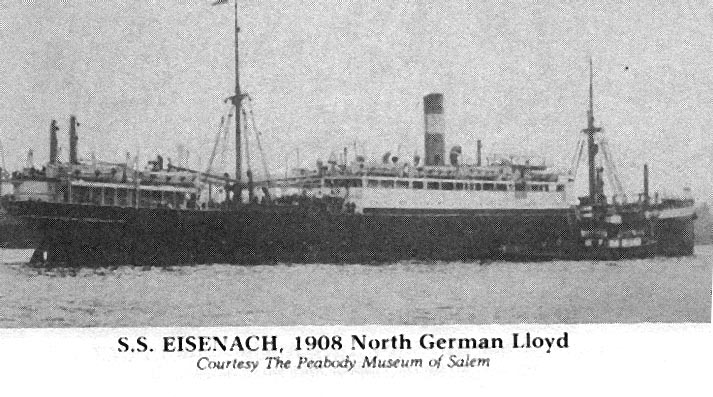
Izzy was the only one of his siblings to immigrate to the US. He immigrated on the Eisenach that sailed from Bremen on 14 May 1913 and arrived in Baltimore Jun 1913. He is listed as SRUL STRELECKI and the ship manifest states he was eighteen, from Radin, and a tailor. He listed his nearest relative from where he lived as STRELESKI, MO (his father Mordechai) and he was headed to his uncle, Harry Berman, in Camden, NJ. Mordechai's sister-in-law (Harry's wife) had sent a ticket to Izzy's father hoping Mordechai would come to the US. Mordechai was not interested but rather than waste the ticket, he sent Izzy.
The EISENACH was
6,757 gross tons, 419.6ft x 54.5ft, single screw, speed 12 knots, accommodation for 50-1st and 900-3rd class passengers. She was built in 1908
by Bremer Vulkan, Vegesack for their own account
but because of a continuing depression, she was not put into service until 1910 when she was sold to North German Lloyd. She sailed on the South American run to Brazil and Argentina -
Bremen to La Plata.
The ship was interned in Pernambuco on the outbreak of WW1 and became owned in Brazil. Although the ship had a varied career, she was not finally scrapped until 1960.
The voyage to Baltimore in 1913 was her only sailing to North America.
Summarized from Norddeutschr Lloyd, Bremen vol.1 by Edwin Drechsel
President Grant
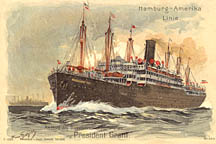
CHARLES STRELSER (Scholem Streletzlly) came to the US on The President Grant that departed Hamburg and arrived in New York on July 16, 1911. Erroneously listed a “Scholen”, he was seventeen years old, traveling alone and was professed to be a locksmith. His last permanent residence was listed as Wilna where his father, Abram Streletsky lived. He stated he was going to New York.
The manifest shows he had $25 but no ticket to his final destination. He claimed to be going to his brother, Sam Streltsky on 90 [ Madison?] St. At the time, Charles was 5’7” tall, fair-haired with brown eyes. According to the manifest, he was born in Wilna, Russia.
The PRESIDENT GRANT had a long and varied career. She was built in 1903 by Harland & Wolff at Belfast as the SERVIAN for Wilson and Furness - Leyland Line's North Atlantic service, which failed to materialise. Her details were - 18,072 gross tons, length 599ft x beam 68.2ft, one funnel, six masts, twin screw and a speed of 14 knots. She had accommodation for 200-1st, 150-2nd, 704-3rd and 2,300-4th class passengers. Launched on February 19, 1903, she spent four years at anchor in the Musgrave Channel, Belfast until purchased by Hamburg America Line, who originally intended to name her BERLIN, but instead named her PRESIDENT GRANT. On September 14, 1907 she finally started her maiden voyage from Hamburg to Boulogne, Southampton and New York. In 1914, she took refuge in New York and on August 4th, was interned at Hoboken. Seized by the US authorities in 1917, when America entered the Great War, she operated as a US Navy transport. In October she transferred to the US Army, and made 20 voyages, and in 1920 was used to repatriate Czech troops from Vladivostok [where they had been fighting the Bolsheviks] via Suez to Trieste. In March 1921, she was handed over to the US Shipping Board, renamed PRESIDENT BUCHANAN and laid up until 1923, when she was refurbished and rebuilt with four masts by the Newport News Shipbuilding Co. Her tonnage was reduced to 17,910 and her accommodation altered to 600-cabin class and 600-3rd class passengers. In 1924 she went to the United States Line, who named her REPUBLIC, and on 29/4/1924 she commenced sailing between New York, Plymouth, Cherbourg and Bremen. In 1926, she was converted to carry cabin, tourist and 3rd class passengers and on 17/7/1931 she commenced her last voyage from Hamburg to Southampton, Cherbourg and New York. She then became a US Troopship and ran between San Francisco, Hawaii and Manila and from 1932-1941 was used between New York, Panama, San Francisco and Honolulu. In 1941 she was assigned to the US Navy as AP33 REPUBLIC and was used for Pacific trooping as far afield as Sydney, Australia. Returned to the army in 1945, she was converted at Mobile, Alabama to a Hague Convention Hospital ship and in February 1946, reverted to a troopship and was engaged on repatriation work. She was laid up later the same year, until 1951, when she was scrapped at Baltimore. [North Atlantic Seaway by N.R.P.Bonsor vol.1., p.413] [Merchant Fleets in Profile by Duncan Haws vol.4, p.98]
SS New York

NEW YORK (2) / CITY OF NEW YORK / HARVARD PLATTSBURG 1888
The "New York" was built by J & G.Thomson, Glasgow in 1888 for the Inman line as the "City of New York". She was a 10,499 gross ton vessel with a clipper stem, length 527.6ft x beam 63.2ft, three funnels, three masts, twin screw and a speed of 20 knots. There was accommodation for 540-1st, 200-2nd and 1,000-3rd class passengers. Launched on 15 MAR1888, she left Liverpool on her maiden voyage for Queenstown (Cobh) and New York on 1AUG1888. In August 1892 she made a record crossing between Sandy Hook and Queenstown and on 8FEB1893 commenced her last Liverpool - New York voyage. On 22FEB1893 she went to the American Line and was put under the US flag. She was then renamed "New York" and her accommodation altered to carry 290-1st, 250-2nd and 725-3rd class passengers. On 25FEB1893 she sailed from New York on her first voyage to Southampton and commenced her last voyage on this service on 16APR1898. She then became the US Armed Cruiser "Harvard" until 11JAN1899 when she resumed the New York - Southampton service as the "New York". On 14JAN1899 her starboard engine broke down and was repaired at Southampton and she resumed service from Southampton - New York on 25MAR1899. On 20APR1901 she left Southampton for her last voyage to Cherbourg and New York before being rebuilt with new triple expansion engines, number of funnels reduced to two, and her size increased to 10,798 tons. On 15APR1903 she resumed the New York - Cherbourg - Southampton service and in 1913, her first class passenger accommodation was downgraded to second class. Commenced her last voyage Southampton - Cherbourg - New York on 1AUG1914 and was transferred to the New York - Liverpool run on 14AUG1914. In April 1918 she made her last run from Liverpool to New York and then became the US Transport "Plattsburg". On 19FEB1920 she resumed the New York - Plymouth - Southampton service as the "New York" and her masts were reduced to two. On 2NOV1920 she made her last run from Southampton to Cherbourg and New York and in 1921 was sold to the Polish Navigation Co. who retained her name and used her for one round voyage New York - Antwerp - Danzig - Southampton - Cherbourg - Brest - New York. She was then seized for debt and sold. In 1922 she went to the Irish American Line and later the same year to the United Transatlantic Line. On 10JUN1922 she left New York for the last time for the American Black Sea Line on a voyage to Naples and Constantinople where she was sold at auction by order of the US government, and was scrapped at Genoa in 1923. [North Atlantic Seaway by N.R.P.Bonsor, vol.1, p.244]
SS BARCELONA

Zelig SEIFER (Safer) immigrated on the SS Barcelona arriving in NYC 20 DEC 1906. He is listed as "Selig Seifer" age 21, single, a tinsmither, had $14 and stated that his last residence was Prusan (Pruzzeneh). He was 5'6", had light brown hair and blue eyes. He was going to his sister, PESCHE SEIFER.
NOTE: Zelig appears to be traveling with two other people from Pruzhany ... (1) Chaim Friedman who is traveling to his brother, Avrum Friedman. Chiam is also 21, listed as a shoemaker (?), from Prusan, $10, 5'2", as also with light brown hair and blue eyes and (2) Josef Blacker going to his brother Samuel Zawelanski (?) in Philadelphia. (Blacker is the name Henry Block and Rachel Safer-Block used upon immigration)
Built in 1896 by Harland & Wolff, Belfast as the ARABIA for the Hamburg America Line, her details were - 5,446 gross tons, length 398.3ft x beam 49ft, one funnel, two masts, single screw and a speed of 13 knots. There was capacity for 20-1st and 1,100-3rd class passengers. Launched on 21/11/1896, she sailed on her maiden voyage from Hamburg for Boston, Philadelphia and Baltimore on 17/3/1897. On 8/5/1897 she commenced the first of three Hamburg - Montreal sailings and subsequently sailed between Hamburg and New York or Philadelphia. She started her last Hamburg - New York voyage on 12/5/1899 and was then sold to Sloman of Hamburg and renamed BARCELONA. She resumed Hamburg - New York sailings for her new owners on 5/7/1899, and in May 1903 was chartered back to Hamburg America Line. They eventually repurchased her from Sloman in 1907 and she continued North Atlantic voyages until 16/5/1914 when she started her last Hamburg - Baltimore sailing. In June 1914 she started her first New York to the Mediterranean crossing, on route to the Black Sea and was seized by Italy in 1915. Renamed ANCONA, and used by Italian owners until 1924 when she was scrapped. [North Atlantic Seaway by N.R.P.Bonsor, vol.1,p.403]
SS Moltke

Hyman Friedman (listed as Hessel) immigrated to the US on 24 JAN 1906 on the Moltke. We was eighteen years old and single. His port of departure was Hamburg. He stated his last place of residence was Grusd (Grodno?) and he was Russian and Hebrew.
MOLTKE / PESARO 1901
The MOLTKE was built by Blohm & Voss, Hamburg in 1901 for the Hamburg America Line. Her details were 12,335 gross tons, length 525.6ft x beam 62.3ft, two funnels, two masts, twin screw and a speed of 16 knots. There was accommodation for 390-1st, 230-2nd and 550-3rd class passengers. Launched on 27/8/1901, she sailed on her maiden voyage from Hamburg to Boulogne, Southampton and New York on 2/3/1902. On 3/4/1906 she commenced her first sailing between Naples, Genoa and New York and her last voyage, Genoa - Naples - New York - Genoa on 23/6/1914. She was interned at Genoa in 1914 and on 25/5/1915 she was seized by Italy and renamed PESARO. She commenced her first voyage for the Italian company, Lloyd Sabaudo, on 23/4/1919 when she sailed from Genoa for Marseilles and New York. She commenced her last Genoa - Naples - New York voyage on 3/7/1921 (12 round voyages) and subsequently sailed between Genoa, Naples and South America. She was scrapped in 1925 in Italy. [North Atlantic Seaway by N.R.P.Bonsor, vol.1,p.407]
ZEELAND

BESSIE ZEMSER immigrated to the US in January 1908. Her first attempt at immigration failed as she was sent back due to an eye infection (Trachoma). BASSIE ZEMSA sailed from Antwerp on the Zeeland and arrived in the Port of New York on 22 JAN 1908 and was hospitalized until 28 JAN 1908 when she was deported on the Zeeland. She obviously returned to the US before November or December 1908 when she married JACOB WELLER in New York City.
ZEELAND / NORTHLAND / MINNESOTA 1901
11,905 gross tons, length 561.6ft x beam 60.2ft, two funnels, four masts, twin screw, speed 15 knots, accommodation for 342-1st, 194-2nd and 626-3rd class passengers. Launched on 24th Nov.1900 by John Brown & Co., Glasgow as the ZEELAND for the Red Star Line, she was registered under the British flag. 13th Apr.1901 first voyage Antwerp - New York, 5th Mar.1910 last voyage Antwerp - Dover - New York. 19th Apr.1910 chartered to White Star Line and started Liverpool - Boston sailings. She made her fourteenth and last sailing on this service in Sep.1911 and on 21st Oct.1911 resumed Antwerp - Dover - NY sailings for Red Star Line. 13th Jul.1912 transferred to Belgian registry but continued the same service. On 18th Jul.1914 she started her last voyage on this route and on 11th Sep.1914 returned to the British flag and began Liverpool - NY voyages. Chartered to White Star-Dominion Line, she was used from Nov.1914 on the Liverpool - Quebec - Montreal service. Dec.1914 Liverpool - Halifax - Portland. Her last voyage on this service started Jan.1915 and she was then transferred to the International Navigation Co., Liverpool and renamed NORTHLAND. Mar.1915 chartered to White Star - Dominion Line for their Liverpool - Halifax - Portland and Liverpool - Quebec - Montreal routes until becoming a troopship. In Aug.1916 she resumed the same services for White Star - Dominion Line until Feb.1919 when she was chartered to American Line and sailed Liverpool - Philadelphia for four round voyages. On 18th Aug.1920 she resumed the Antwerp - Southampton - NY service as the ZEELAND under the British flag for Red Star Line, starting her last voyage on 8th Oct.1926. 1927 sold to Atlantic Transport Line, renamed MINNESOTA and fitted with tourist class only accommodation. 30th Apr.1927 first voyage London - NY. 21st Sep.1929 last voyage London - NY. 1930 scrapped at Inverkeithing. [North Atlantic Seaway, vol.2, p.855 by N. Bonsor]
Graf Waldersee

Steamship Line: Hamburg-American LineBuilt: Blohm & Voss, Hamburg, Germany Year Built: 1898 Routes: Hamburg-NY Passengers: 1st class: 162; 2nd class 184: 3rd class: 2,200 History: Sold to British shipbreakers in July 1921. Machinery: Twin-screw, 13.5 knots Masts and funnels: 4 masts, 1 funnel
Tongariro
TONGARIRO 4,163 g.t. 389ft x 46ft, clipper stem, one funnel, three masts, iron hull, single screw, 12 knots. 80-1st, 80-2nd, 250-3rd class passengers. (sister ship to RUAPEHU). Built J. Elder &Co, Glasgow. Launched in Aug.1883 for NZSCo, London - NZ service. Chartered to Beaver Line and started first Liverpool - Quebec - Montreal sailing 6/8/1898. Eighth and last sailing on this service May 1899. Sold British India SN Co 1900, renamed ZIBENGHLA. Scrapped Bombay 1910.

PENNLAND / ALGERIA 1870
Schaye DUBINER, age 26, immigrated to Philadelphia 16 May 1898 on The SS PENNLAND. He had $19 and was going to his brother-in-law, D. POMERANZOW in New York. It was a 3428 gross ton ship, length 361.2ft x beam 41.4ft, one funnel, three masts, rigged for sail, iron hull, single screw and a speed of 13 knots. Accommodation for 200-1st and 1,054-3rd class passengers. Built by J.& G.Thomson, Glasgow, she was launched on 12th Jul.1870 as the ALGERIA for the Cunard SS Co. Her maiden voyage started 27th Sep.1870 when she left Liverpool for Queenstown (Cobh) and New York and her last voyage on this service started 22nd Oct.1881. Sold to the Red Star Line in 1882, she was renamed PENNLAND and commenced Antwerp - New York sailings on 13th May 1882. Rebuilt to 3,760 tons in 1888, she started her last Antwerp - New York voyage on 15th Dec.1894. On 11th Apr.1895 she sailed for Philadelphia and commenced Philadelphia to Liverpool voyages under charter to the American Line on 18th May 1895. Her last sailing on this route started 6th Apr.1901 and she then resumed Antwerp - New York sailings. In Aug.1901 she resumed the Antwerp - Philadelphia route and in 1902 became 3rd class only. Her last Antwerp - New York voyage started 27th Mar.1902 and her last Philadelphia - Antwerp on 23rd Sep.1903. She was then scrapped in Italy.
VIOLA
1893 324 1940 sold to Angbats A/B Aland.

ÜReturn to Main Immigration Page










